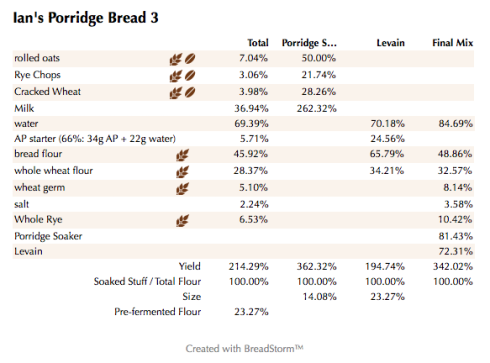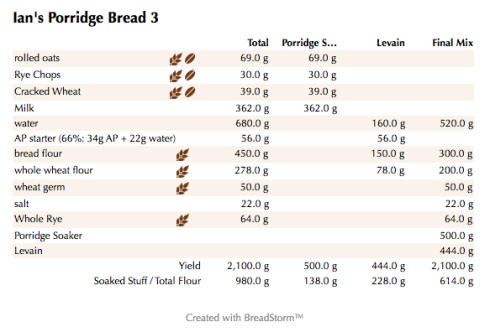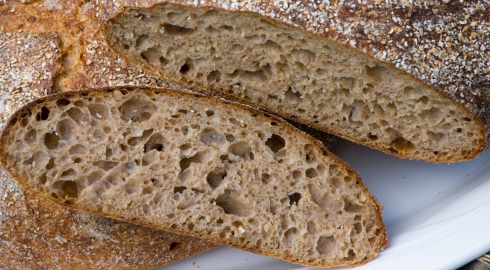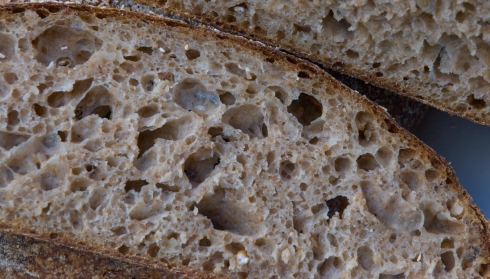
Porridge Bread Part III

I'm really loving the whole porridge in bread thing. Last week I adapted the original version to my own technique and it came out great, so now I figured it was time to get some more whole grain goodness into this formula.
I decided to make a double sized recipe this time so I would have one to freeze for later in the week but didn't realize my baking stone is not big enough to fit 2 of these big boys at the same time. I really need to get some baking stone squares to utilize the rest of my oven. Anyway, I changed up the porridge part by adding cracked wheat and rye chops to the rolled oats along with milk instead of water. I think this really added to the flavor of this bread in a good way.
I also added some whole rye to the main dough as well as increased the amount of whole wheat of which I used my freshly milled version. The rest of the formula was the same as last time.
The final bread came out excellent, with the extra whole grains really giving this a much stronger sourdough flavor and nutty flavor. Definitely a bread worth baking again and again.
I know some of you enjoy my photos from my gardens and some of the flowers are starting to bloom so I hope you don't mind that I inserted a few in this post.
Here are the Zip files for the above BreadStorm files.
Levain Directions
Mix all the levain ingredients together for about 1 minute and cover with plastic wrap. Let it sit at room temperature for around 7-8 hours or until the starter has doubled. I used my proofer set at 83 degrees and it took about 4 hours.
Oat Porridge Directions
Add about 3/4's of the milk called for in the porridge to the dry ingredients in a small pot set to low and stir constantly until all the milk is absorbed. Add the remainder of the milk and keep stirring until you have a nice creamy and soft porridge. Remove from the heat and let it come to room temperature before adding to the dough. I put mine in the refrigerator and let it cool quicker.
Main Dough Procedure
Mix the flours and wheat germ and the water for about 1 minute. Let the rough dough sit for about 20 minutes to an hour. Next add the levain, cooled porridge and salt and mix on low for 4 minutes and speed #2 for another 2 minutes or by hand for about 6 minutes. You should end up with a cohesive dough that is slightly tacky but very manageable. Remove the dough from your bowl and place it in a lightly oiled bowl or work surface and do several stretch and folds. Let it rest covered for 10-15 minutes and then do another stretch and fold. Let it rest another 10-15 minutes and do one additional stretch and fold. After a total of 2 hours place your covered bowl in the refrigerator and let it rest for 12 to 24 hours. (Since I used my proofer I only let the dough sit out for 1.5 hours before refrigerating). Note: this is a pretty wet dough so you may need to do a couple of additional stretch and folds.
When you are ready to bake remove the bowl from the refrigerator and let it set out at room temperature still covered for 1.5 to 2 hours. Remove the dough and shape as desired.
The dough will take 1.5 to 2 hours depending on your room temperature and will only rise about 1/3 it's size at most. Let the dough dictate when it is read to bake not the clock.
Around 45 minutes before ready to bake, pre-heat your oven to 550 degrees F. and prepare it for steam. I have a heavy-duty baking pan on the bottom rack of my oven with 1 baking stone on above the pan and one on the top shelf. I pour 1 cup of boiling water in the pan right after I place the dough in the oven.
Right before you are ready to put them in the oven, score as desired and then add 1 cup of boiling water to your steam pan or follow your own steam procedure.
After 5 minute lower the temperature to 450 degrees. Bake for 35-50 minutes until the crust is nice and brown and the internal temperature of the bread is 205 degrees.
Take the bread out of the oven when done and let it cool on a bakers rack before for at least 2 hours before eating.
Below was my dinner from a few nights ago. Nothing as fancy as DA, but not too shabby :). Some pasta with caramelized onions, grilled red peppers, grilled corn, fresh mozzarella, shaved Parmesan, and mushroom pork sausages along with a grilled slice of Porridge Bread.















Comments
Looks perfect inside and out. Has to be really tasty. Your past white bread. Now that we have you on the darker side, Lucy thinks if you toast the wheat germ with the rye chops, oats, and cracked wheat making Toadies first, and then porridge then with the milk, the flavor will be even more deeply intense. But she is often wrong :-) This one is a keeper.
Love the pasta and the flowers in your yard. You could never have anything like that in the desert. Even the bugs that try to fly are turning into little puffs of smoke in the air now! I've never ecen seen any of those plants. Your yard would be called a botanical garden here..
Lucy say HI to Max,Lexi and the 5 furies. Well Done and
Happy Baking Ian
Thanks DA. That's a good idea about toasting some of the ingredients first. You should try this one and see if you like it.
It's finally starting to feel like summer here as today it was in the 80's but very humid so it felt much hotter. Obviously nothing like what you have. Took the doggies to the beach a little while ago to cool off and they had a blast.
Hi to Lucy and look forward to your next bake.
Regards,
Ian
Your bread looks wonderful and your flowers beautiful. You have really mastered the porridge. Have your veered from the tartine method of developing the gluten a bit before incorporating the porridge?
Leah
Thank you Leah.
I have changed a few things from Tartine, but I do mix the flour and water together for about 1-2 minutes and let it autolyse or rest about 30 minutes to an hour. This let's the flour absorb the water. In any event either method works great. I find my overall method fits better in my schedule and is a little more convenient.
Regards,
Ian
Wonderful bread, Ian.
What an open crumb for such a porridge bread. Impressive!
Garden is just fantastic.
Khalid
Thank you Khalid.
I know you would like the flavor of this one. I hope you get a chance to try it soon. I think your customers may like it.
Look forward to hearing about your further adventures for your bakery.
Regards,
Ian
Ian, you got my attention on two levels today, your successful exploration of incorporating porridges in bread and your delightful garden, each clearly a labor of love. As a landscape architect, I definitely appreciate both. Don't you just love Spring/Summer?
I've been going, as DAB refers, to the 'dark side' of whole grains over the past few years and have recently begun testing with soakers and porridges, too. Tried Emkay's Polenta Bread a few weeks ago and feel I must have gotten the hydration wrong. She mentioned in her blog that she intended to add more polenta the next time, so I jumped to Plan B and did so on my attempt. Between the polenta and the rye, I ended up with a relentlessly sticky dough that I slapped & folded, stretched & folded, rested, lather-rinse-repeated, talked to firmly and finally gave in, floured, shaped and chilled. It baked out okay, but slumped a bit, so even with decent spring, it wasn't as high as I had wanted. I enjoy and am encouraged by your progress, and will continue to practice, practice, practice. Even the disappointments are edible!
Cathy
Thank you Cathy for your comments.
I love this time of year and I'm waiting patiently for all of our cone flowers to start blooming. They have come out with so many new ones the last few years and we must have at least 10 varieties.
On the bread front, I highly suggest you give this one or the last one a try. This method is easier than the Tartine method and it comes out as good if not better. This version with the added whole grains really came out great and if you like the dark side you will love it.
Look forward to hearing how your progress goes.
Regards,
Ian
The bread and the garden are looking mighty fine, Ian. I've been on a porridge bread kick lately too and it's all your fault. :) :) :)
Mary
Thank you Mary....once you start with this porridge kick it's hard to stop! Look forward to reading about your next bake.
Regards,
Ian
Hi, sorry for the late reply. I only just saw your comment now by chance.
First, thanks for your kind words.
In regards to the starter, you can certainly use a different hydration starter if you prefer but I would stick to under 70% if you can. I usually take some of my mother starter and make a fresh levain for the dough or if I happen to have just refreshed the mother starter I will use some of that instead depending on the type of starter I am using. If you understand baker's %'s you can adapt the recipe to the hydration level of the starter you are using.
I am using Bob's Red Mill, Hard Red Spring Wheat Berries and I have also used similar berries I bought bulk at Whole Foods.
Yes the dough did do it's final proof in a banneton. The dough was bulk retarded in the refrigerator overnight. The next day the bulk dough is rested at room temperature or in my proofer at 78 degrees - 80 degrees for 1.5 hours or less depending on how it is reacting. Then it is divided, shaped and proofed before going into the oven. The original recipe from Tartine 3 which this was adapted from using an overnight retardation of the shaped loaves but I prefer this method and my results are as good if not better in my opinion :).
I used organic oat bran sprinkled on the bottom of the banneton. I do like the appearance it adds.
I hope this answers all of your questions. Please don't hesitate to ask more or you can also send me a private message if you wish and I will get back to you as soon as possible.
Regards,
Ian